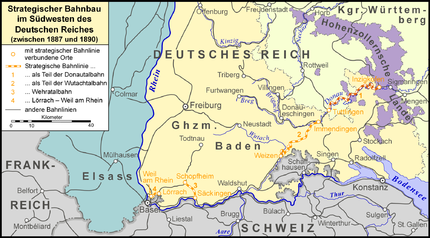
Strategic railway
Encyclopedia

Military strategy
Military strategy is a set of ideas implemented by military organizations to pursue desired strategic goals. Derived from the Greek strategos, strategy when it appeared in use during the 18th century, was seen in its narrow sense as the "art of the general", 'the art of arrangement' of troops...
purposes, as opposed to the usual purpose of a railway, which is the transport of civilian passengers or freight
Freight train
A freight train or goods train is a group of freight cars or goods wagons hauled by one or more locomotives on a railway, ultimately transporting cargo between two points as part of the logistics chain...
. Although the archetypal strategic railway would be one constructed solely as part of a military strategy, such a railway has only ever existed in theory. Thus, a strategic railway is, in practice, one for which any intended or contemplated civilian purpose is subordinate to the military strategic purpose.
Strategic railways are not to be confused with military railways, which can take several different forms. A military railway is established or operated not as a strategic measure, but for tactical
Military tactics
Military tactics, the science and art of organizing an army or an air force, are the techniques for using weapons or military units in combination for engaging and defeating an enemy in battle. Changes in philosophy and technology over time have been reflected in changes to military tactics. In...
, training or logistical
Logistics
Logistics is the management of the flow of goods between the point of origin and the point of destination in order to meet the requirements of customers or corporations. Logistics involves the integration of information, transportation, inventory, warehousing, material handling, and packaging, and...
purposes. However, it is possible for a railway to be proposed or constructed for more than one military purpose, including a strategic purpose. An example of such a railway is the notorious Burma Railway, the hasty construction of which was as much a strategic measure as a tactical one.
Apart from the Burma Railway, the best known of all strategic railways is probably the so-called Kanonenbahn (Cannons Railway), which linked Berlin
Berlin
Berlin is the capital city of Germany and is one of the 16 states of Germany. With a population of 3.45 million people, Berlin is Germany's largest city. It is the second most populous city proper and the seventh most populous urban area in the European Union...
with Metz
Metz
Metz is a city in the northeast of France located at the confluence of the Moselle and the Seille rivers.Metz is the capital of the Lorraine region and prefecture of the Moselle department. Located near the tripoint along the junction of France, Germany, and Luxembourg, Metz forms a central place...
, and was opened progressively between 1850 and 1882. As its name suggests, the Kanonenbahn was intended primarily to facilitate the movement of soldiers and materiel
Materiel
Materiel is a term used in English to refer to the equipment and supplies in military and commercial supply chain management....
, including cannon
Cannon
A cannon is any piece of artillery that uses gunpowder or other usually explosive-based propellents to launch a projectile. Cannon vary in caliber, range, mobility, rate of fire, angle of fire, and firepower; different forms of cannon combine and balance these attributes in varying degrees,...
s, from central Prussia
Kingdom of Prussia
The Kingdom of Prussia was a German kingdom from 1701 to 1918. Until the defeat of Germany in World War I, it comprised almost two-thirds of the area of the German Empire...
towards eastern France
Second French Empire
The Second French Empire or French Empire was the Imperial Bonapartist regime of Napoleon III from 1852 to 1870, between the Second Republic and the Third Republic, in France.-Rule of Napoleon III:...
, during an era of diplomatic tension
Causes of the Franco-Prussian War
The causes of the Franco-Prussian War are deeply rooted in the events surrounding balance of power after the Napoleonic Wars. France and Prussia had been combatants against each other, with France on the losing side and Napoleon I exiled to Elba...
and warfare
Franco-Prussian War
The Franco-Prussian War or Franco-German War, often referred to in France as the 1870 War was a conflict between the Second French Empire and the Kingdom of Prussia. Prussia was aided by the North German Confederation, of which it was a member, and the South German states of Baden, Württemberg and...
between the two countries.
Although most of the world's strategic railways had been constructed, not always to completion, by the end of World War II
World War II
World War II, or the Second World War , was a global conflict lasting from 1939 to 1945, involving most of the world's nations—including all of the great powers—eventually forming two opposing military alliances: the Allies and the Axis...
, a number of additional strategic railways were built and operated in eastern bloc
Eastern bloc
The term Eastern Bloc or Communist Bloc refers to the former communist states of Eastern and Central Europe, generally the Soviet Union and the countries of the Warsaw Pact...
countries during the Cold War
Cold War
The Cold War was the continuing state from roughly 1946 to 1991 of political conflict, military tension, proxy wars, and economic competition between the Communist World—primarily the Soviet Union and its satellite states and allies—and the powers of the Western world, primarily the United States...
. Progressive changes in military technology, combined with the always high cost of constructing heavy rail systems, make it much less likely that a strategic railway would be constructed in the 21st century than in the 19th or 20th centuries.

